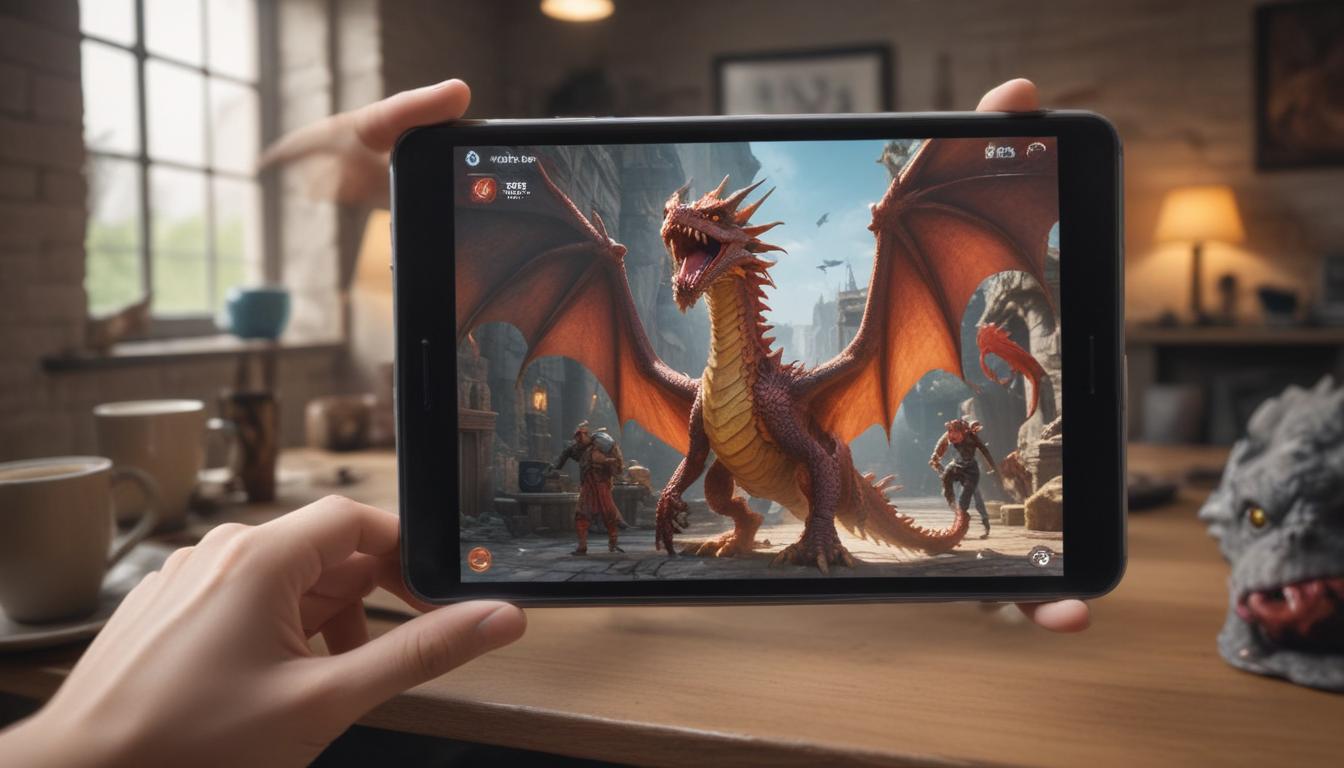Now Reading: Build Your First AR Game
- 01
Build Your First AR Game
Build Your First AR Game

Augmented Reality Game Development Your Ultimate Guide for 2024
Have you ever dreamed of seeing dragons land on your coffee table or battling digital monsters in your own backyard? This is the magic of augmented reality gaming. Yet, for many aspiring developers and creators, the path to building these immersive experiences seems shrouded in complexity. You might feel overwhelmed by the technical jargon, the variety of tools, and the challenge of blending the digital with the real world seamlessly. This guide is your solution. We will demystify the process, breaking down augmented reality game development into clear, manageable steps.
This journey will equip you with the fundamental knowledge to turn your imaginative AR game concept into a tangible reality. We will explore the essential technologies, walk through the development lifecycle from idea to launch, and look ahead at the exciting future of this revolutionary gaming frontier. Forget the confusion and intimidation. By the end of this article, you will have a solid roadmap to begin creating your very own augmented reality games that captivate and delight players.
What Is Augmented Reality Game Development
Augmented reality game development is the process of creating interactive experiences that overlay computer-generated images, sounds, and information onto the real world. Unlike virtual reality (VR), which transports the user to a completely digital environment, AR enhances the player’s current surroundings. Think of your smartphone or a pair of AR glasses as a magic window. When you look through it, your familiar world is suddenly populated with new characters, objects, and gameplay elements that you can interact with.
The goal is to create a believable and engaging fusion of the real and the virtual. A successful AR game makes the player feel like the digital content is truly present in their physical space. This is achieved through sophisticated technology that understands the environment, including plane detection (finding flat surfaces like floors and tables), image tracking (recognizing specific images), and world tracking (mapping the room to maintain the position of virtual objects as you move). This unique blend allows for gameplay mechanics that are impossible in any other medium, from location-based scavenger hunts to tabletop strategy games that unfold right before your eyes.
Key Technologies and Tools for AR Game Development
Choosing the right technology stack is one of the most critical decisions you will make. Your choice of software development kits (SDKs) and game engines will define your capabilities, target platforms, and development workflow. This foundation determines how your game will “see” and interact with the real world, so it’s essential to understand the major players in the space.
Fortunately, the ecosystem for AR development is more mature and accessible than ever. Powerful tools from tech giants like Apple, Google, and Unity have lowered the barrier to entry, empowering both solo developers and large studios to build incredible AR experiences. Let’s dive into the core components you’ll need to get started.
Choosing Your AR SDK
The AR Software Development Kit (SDK) is the bridge between your game and the device’s camera and sensors. It provides the core functionality for understanding the real world. For mobile AR, the two primary platform-specific SDKs are Apple’s ARKit and Google’s ARCore. ARKit is designed exclusively for iOS devices (iPhones and iPads) and is known for its robust performance, advanced features like body tracking and scene geometry, and seamless integration with the Apple ecosystem. If your target audience is primarily on Apple devices, ARKit is a fantastic choice.
On the other hand, Google’s ARCore is built for a wide range of supported Android devices. Its strength lies in its broad reach and powerful features like its Geospatial API, which allows for anchoring content to real-world locations with incredible precision. For developers aiming for cross-platform compatibility, tools like Niantic Lightship and Vuforia are excellent options. Lightship, from the creators of Pokémon GO, is built for creating real-world metaverse experiences at scale. Vuforia is a veteran in the space, offering powerful image and object recognition features that are ideal for marker-based AR games and brand activations.
Selecting the Right Game Engine
While the SDK handles the “reality” part of AR, the game engine is where you build the “game.” It’s the creative suite where you’ll import 3D models, write game logic, create user interfaces, and manage audio. The two dominant game engines in the industry, Unity and Unreal Engine, both offer outstanding support for AR development. Unity has long been the go-to choice for many mobile and indie game developers due to its user-friendly interface, massive asset store, and strong community support. It integrates smoothly with ARKit, ARCore, and other third-party SDKs through its AR Foundation framework, which allows you to build once and deploy to both iOS and Android.
Unreal Engine is renowned for its cutting-edge graphics and visual fidelity, making it a powerhouse for creating hyper-realistic AR experiences. While it traditionally has a steeper learning curve, its powerful Blueprint visual scripting system allows non-programmers to build complex game logic. Unreal’s native support for ARKit and ARCore is also robust, making it a viable and compelling option for projects that demand the highest level of graphical quality. Your choice between Unity and Unreal will often come down to your team’s familiarity with the engine, your project’s visual goals, and your target hardware.

The AR Game Development Process Step by Step
Building an AR game follows a structured process, moving from a creative spark to a polished product on an app store. Each stage presents unique challenges and opportunities specific to augmented reality. Unlike traditional game development, you must constantly consider how your game will perform in the unpredictable and varied environments of your players.
This step-by-step guide breaks down the typical lifecycle of an AR game project. Following this structure will help you stay organized, tackle technical hurdles systematically, and ensure that your final product is not only functional but also genguinely fun and immersive.
Ideation and Concept Design
This is the most crucial stage. A great AR game isn’t just a traditional game with the real world as a background; it’s a game that could only exist in AR. Brainstorm core mechanics that leverage the unique aspects of the technology. How will players interact with virtual objects? Will the game use location data to encourage exploration? Is it a tabletop game that uses a specific surface, or a room-scale experience that transforms a whole space?
During this phase, you must also think deeply about the user’s context. Players will be in different environments with varying lighting, space, and potential obstacles. Your design must prioritize player safety and comfort. For example, a game that requires sudden, large movements might not be suitable for a small apartment. A solid concept defines not just the gameplay loop but also the ideal playing conditions, ensuring a positive and safe user experience.
Prototyping and Core Mechanics
With a strong concept in hand, the next step is to build a rapid prototype. The goal here isn’t to create beautiful art but to test your core ideas as quickly as possible. In AR, this means verifying your most significant technical risks. Can your chosen SDK reliably detect surfaces? Is the tracking stable enough for your gameplay? Does the core interaction of placing and manipulating a virtual object feel good?
This stage involves a lot of experimentation. You’ll build simple scenes in Unity or Unreal to test object placement, user interface controls, and basic game logic. This iterative process of building, testing, and refining is vital. It allows you to find the fun and fix technical issues early, long before you’ve invested significant time and resources into creating detailed art assets or complex game systems. A successful prototype proves that your core AR concept is both technically feasible and engaging for the player.
The Future of Augmented Reality Gaming
The world of augmented reality gaming is just getting started, and its future is incredibly bright. We are moving beyond simple mobile games toward a more integrated and persistent digital layer over our world. The development of lightweight, powerful AR glasses is set to be the next major catalyst, removing the need to hold up a phone and enabling truly hands-free, immersive experiences.
Emerging trends like the real-world metaverse point to a future of shared, persistent AR experiences where digital content is anchored to specific locations for all users to see and interact with. Imagine city-wide AR games, collaborative art projects visible only through AR, or educational overlays that bring history to life on the very streets where it happened. As AI becomes more integrated, we can expect smarter, more context-aware AR characters who can react to the real world in believable ways. For developers, this is not just a new platform; it is an entirely new reality to build for.


































